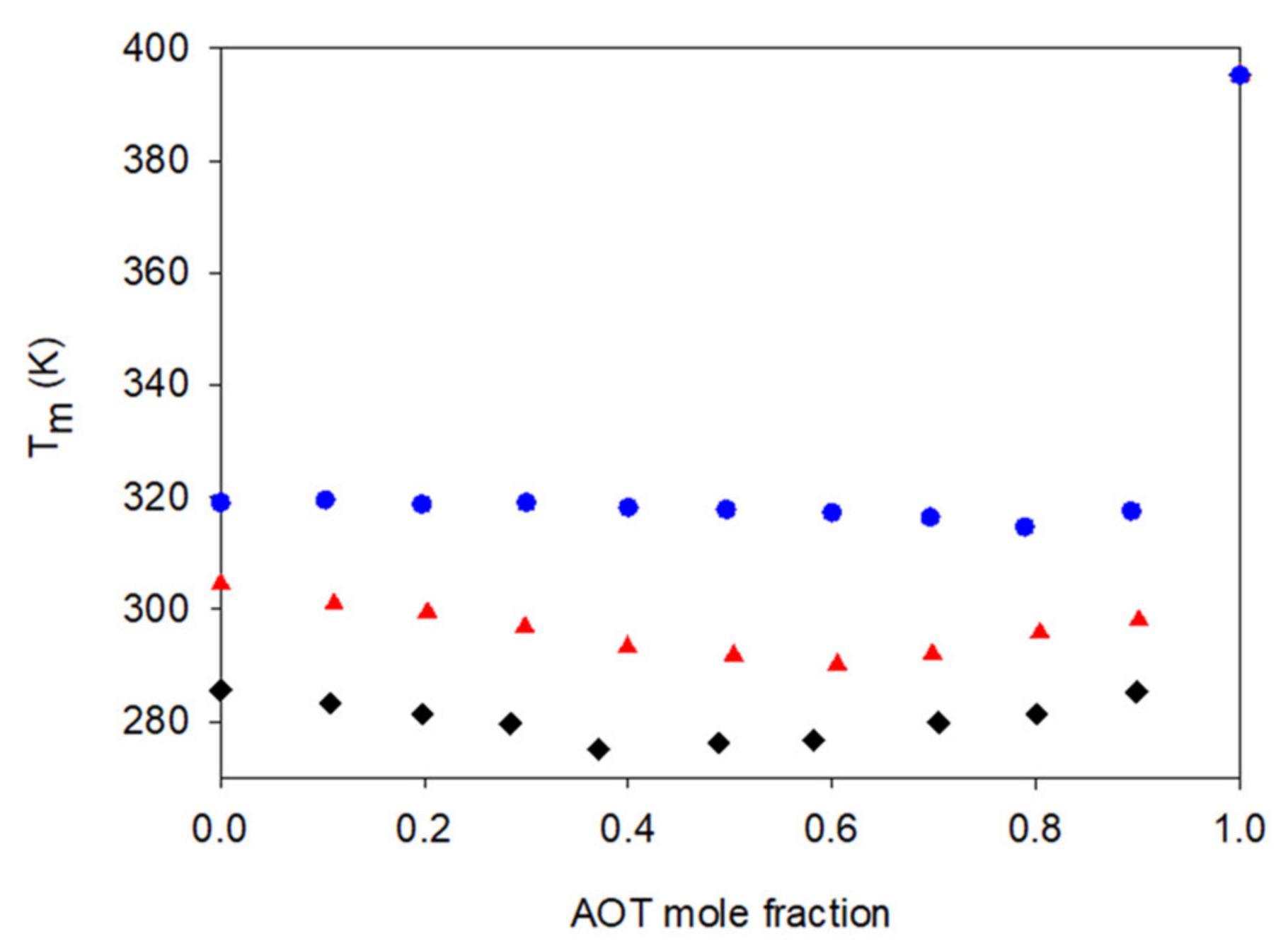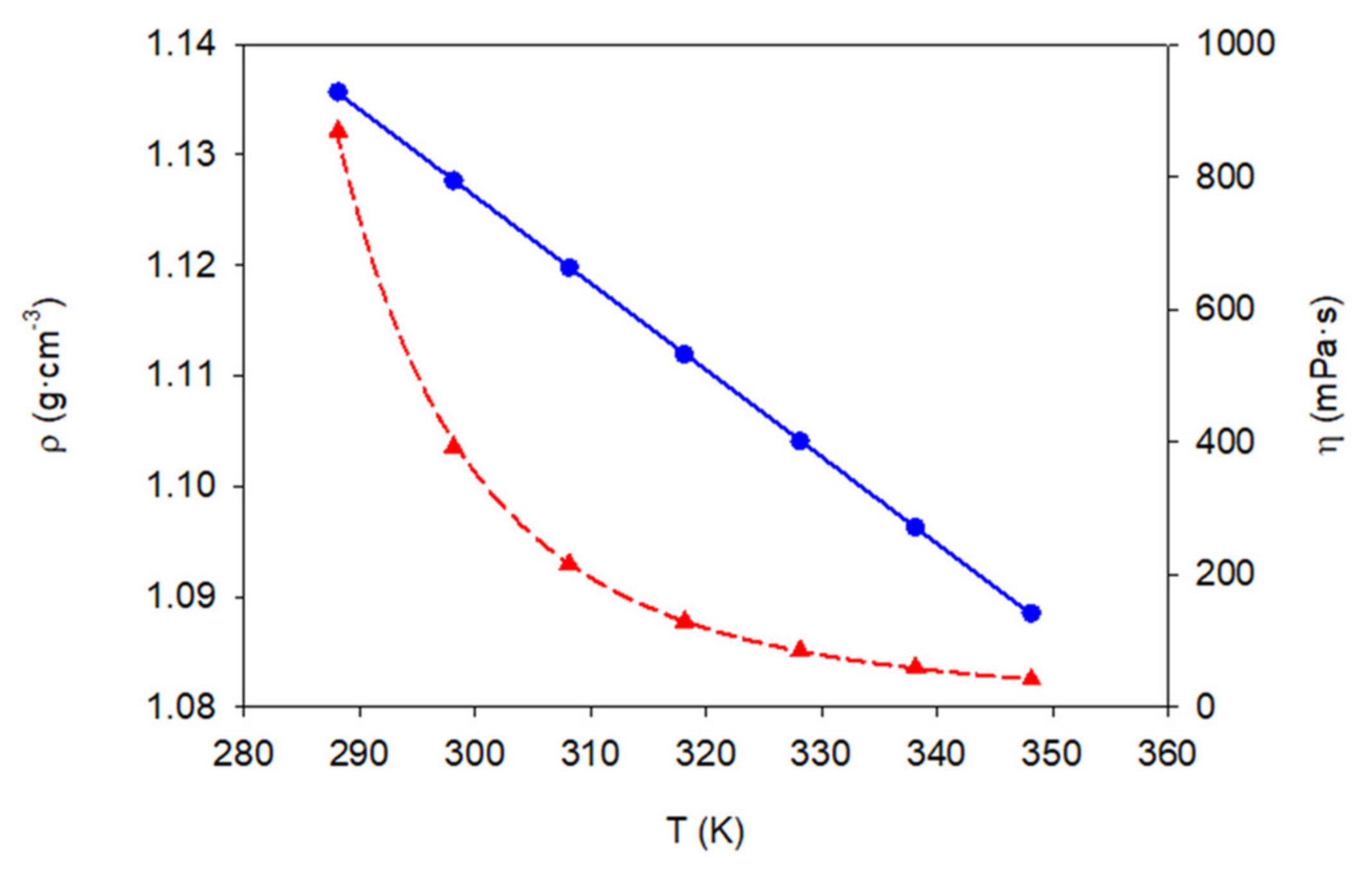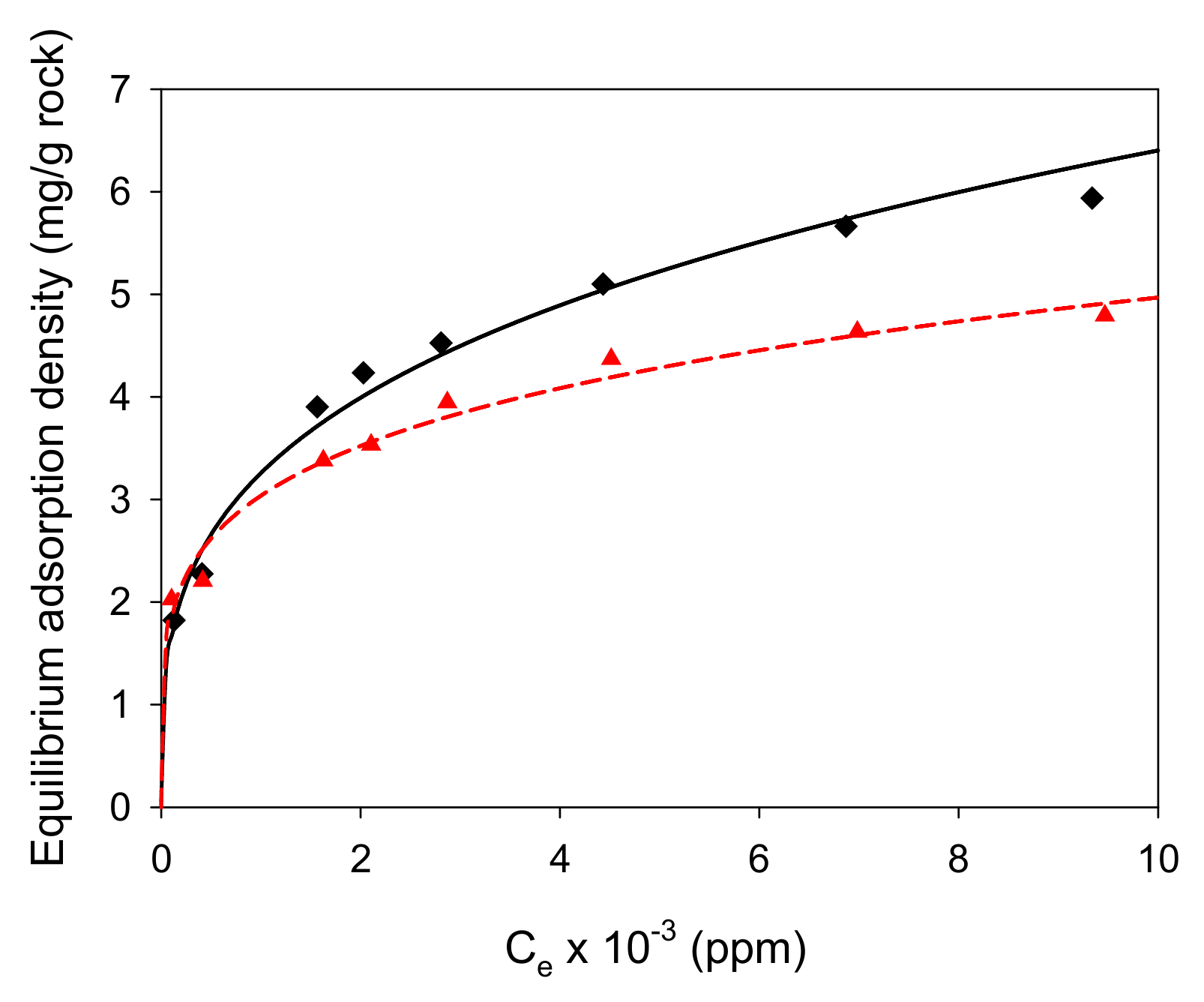AOT + Polyethylene Glycol Eutectics for Enhanced Oil Recovery
Abstract
:1. Introduction
2. Materials and Methods
2.1. Materials
2.2. Methods
2.2.1. Determination of Eutectics
2.2.2. Thermal Stability
2.2.3. Physical Characterization of the Eutectic
2.2.4. EOR
Injectability
Water/Oil IFT Reduction
Adsorption Kinetics
Static Adsorption Experiments
Oil Recovery
3. Results and Discussion
3.1. Determination of Eutectics
3.2. Thermal Stability
3.3. Physical Characterization of the Eutectic
3.4. EOR
3.4.1. Injectability
3.4.2. Water/Oil IFT Reduction
3.4.3. Adsorption Kinetics
3.4.4. Static Adsorption Experiments
3.4.5. Oil Recovery
4. Conclusions
Supplementary Materials
Author Contributions
Funding
Institutional Review Board Statement
Informed Consent Statement
Acknowledgments
Conflicts of Interest
References
- Capuano, L. International energy outlook 2020 (IEO2020). US Energy Inf. Adm. 2020, 2020, 1–7. [Google Scholar]
- Saxena, N.; Goswami, A.; Dhodapkar, P.K.; Nihalani, M.C.; Mandal, A. Bio-based surfactant for enhanced oil recovery: Interfacial properties, emulsification and rock-fluid interactions. J. Pet. Sci. Eng. 2019, 176, 299–311. [Google Scholar] [CrossRef]
- Al-Wahaibi, I.; Al-Wahaibi, Y.; Al-Hajri, R.; Jibril, B.; Shuwa, S. The novel use of malonic acid-based deep eutectic solvents for enhancing heavy oil recovery. Int. J. Oil Gas Coal Technol. 2019, 20, 31–54. [Google Scholar] [CrossRef]
- Vishnyakov, V.; Suleimanov, B.; Salmanov, A.; Zeynalov, E. Primer on Enhanced Oil Recovery; Gulf Professional Publishing: Cambridge, MA, USA, 2019; ISBN 9780128176320. [Google Scholar]
- Franchi, J.R. Principles of Applied Reservoir Simulation; Gulf Professional Publishing: Cambridge, MA, USA, 2018; ISBN 9780128155639. [Google Scholar]
- Horgue, P.; Soulaine, C.; Franc, J.; Guibert, R.; Debenest, G. An open-source toolbox for multiphase flow in porous media. Comput. Phys. Commun. 2015, 187, 217–226. [Google Scholar] [CrossRef] [Green Version]
- Muggeridge, A.; Cockin, A.; Webb, K.; Frampton, H.; Collins, I.; Moulds, T.; Salino, P. Recovery rates, enhanced oil recovery and technological limits. Philos. Trans. R. Soc. A Math. Phys. Eng. Sci. 2014, 372, 20120320. [Google Scholar] [CrossRef] [Green Version]
- Druetta, P.; Picchioni, F. Surfactant flooding: The influence of the physical properties on the recovery efficiency. Petroleum 2020, 6, 149–162. [Google Scholar] [CrossRef]
- Negin, C.; Ali, S.; Xie, Q. Most common surfactants employed in chemical enhanced oil recovery. Petroleum 2017, 3, 197–211. [Google Scholar] [CrossRef]
- Atta, D.Y.; Negash, B.M.; Yekeen, N.; Habte, A.D. A state-of-the-art review on the application of natural surfactants in enhanced oil recovery. J. Mol. Liq. 2021, 321, 114888. [Google Scholar] [CrossRef]
- Gbadamosi, A.O.; Junin, R.; Manan, M.A.; Agi, A.; Yusuff, A.S. An Overview of Chemical Enhanced Oil Recovery: Recent Advances and Prospects. Springer: Berlin/Heidelberg, Germany, 2019; Vol. 9, ISBN 0123456789. [Google Scholar]
- Sheng, J.J. Modern Chemical Enhanced Oil Recovery; Elsevier: Amsterdam, The Netherlands, 2011; ISBN 9781856177450. [Google Scholar]
- Sheng, J.J. Enhanced Oil Recovery. Field Case Studies; Elsevier: Amsterdam, The Netherlands, 2013; ISBN 9780123865458. [Google Scholar]
- Martins, M.A.R.; Pinho, S.P.; Coutinho, J.A.P. Insights into the nature of eutectic and deep eutectic mixtures. J. Sol. Chem. 2019, 48, 962–982. [Google Scholar] [CrossRef] [Green Version]
- Mohsenzadeh, A.; Al-Wahaibi, Y.; Jibril, A.; Al-Hajri, R.; Shuwa, S. The novel use of deep eutectic solvents for enhancing heavy oil recovery. J. Pet. Sci. Eng. 2015, 130, 6–15. [Google Scholar] [CrossRef]
- Shuwa, S.M.; Jibril, B.Y.; Al-Wahaibi, Y.M.; Al-Hajri, R.S. Heavy-oil-recovery enhancement with choline chloride/ethylene glycol-based deep eutectic solvent. SPE J. 2015, 20, 79–87. [Google Scholar] [CrossRef]
- Lee, J.; Babadagli, T. Comprehensive methodology for chemicals and nano materials screening for heavy oil recovery using microemulsion characterization. J. Pet. Sci. Eng. 2018, 171, 1099–1112. [Google Scholar] [CrossRef]
- El-hoshoudy, A.N.; Soliman, F.S.; Mansour, E.M.; Zaki, T.; Desouky, S.M. Experimental and theoretical investigation of quaternary ammonium-based deep eutectic solvent for secondary water flooding. J. Mol. Liq. 2019, 294, 111621. [Google Scholar] [CrossRef]
- Sanati, A.; Rahmani, S.; Nikoo, A.H.; Malayeri, M.R.; Busse, O.; Weigand, J.J. Comparative study of an acidic deep eutectic solvent and an ionic liquid as chemical agents for enhanced oil recovery. J. Mol. Liq. 2021, 329, 115527. [Google Scholar] [CrossRef]
- Sanati, A.; Malayeri, M.R. CTAB adsorption onto dolomite in the presence of ionic liquid and deep eutectic solvent: Experimental and theoretical studies. J. Mol. Liq. 2021, 325, 115176. [Google Scholar] [CrossRef]
- Gabbott, P. (Ed.) Principles and Applications of Thermal Analysis; Blackwell Publishing: New Delhi, India, 2008; ISBN 9781405131711. [Google Scholar]
- Rodríguez-Palmeiro, I.; Rodríguez-Escontrela, I.; Rodríguez, O.; Soto, A.; Reichmann, S.; Amro, M.M. Tributyl(tetradecyl)phosphonium chloride ionic liquid for surfactant-enhanced oil recovery. Energy Fuels 2017, 31, 6758–6765. [Google Scholar] [CrossRef]
- Vonnegut, B. Rotating bubble method for the determination of surface and interfacial tensions. Rev. Sci. Instrum. 1942, 13, 6. [Google Scholar] [CrossRef]
- Hanamertani, A.S.; Pilus, R.M.; Idris, A.K.; Irawan, S.; Tan, I.M. Ionic liquids as a potential additive for reducing surfactant adsorption onto crushed Berea sandstone. J. Pet. Sci. Eng. 2018, 162, 480–490. [Google Scholar] [CrossRef]
- Ahmadi, M.A.; Shadizadeh, S.R. Spotlight on the new natural surfactant flooding in carbonate rock samples in low salinity condition. Sci. Rep. 2018, 8, 1–15. [Google Scholar] [CrossRef] [Green Version]
- Liu, Z.; Zhao, G.; Brewer, M.; Lv, Q.; Sudhölter, E.J.R. Comprehensive review on surfactant adsorption on mineral surfaces in chemical enhanced oil recovery. Adv. Colloid Interfac. Sci. 2021, 294, 102467. [Google Scholar] [CrossRef]
- Bin Dahbag, M.; AlQuraishi, A.; Benzagouta, M. Efficiency of ionic liquids for chemical enhanced oil recovery. J. Petrol. Explor. Prod. Technol. 2015, 5, 353–361. [Google Scholar] [CrossRef] [Green Version]
- Nandwani, S.K.; Malek, N.I.; Chakraborty, M.; Gupta, S. Potential of a novel surfactant slug in recovering additional oil from highly saline calcite cores during the EOR Process: Synergistic blend of surface active ionic liquid and nonionic surfactant. Energy Fuels 2019, 33, 541–550. [Google Scholar] [CrossRef]
- Wheaton, R. Fundamentals of Applied Reservoir Engineering: Appraisal, Economics and Optimization; Elsevier: Amsterdam, The Netherlands, 2016; ISBN 9780081010198. [Google Scholar]
- Haddad, H.; Al Kobaisi, M. Influence of moisture content on the thermal and mechanical properties and curing behavior of polymeric matrix and polymer concrete composite. Mater. Des. 2013, 49, 850–856. [Google Scholar] [CrossRef]
- Seddon, K.R.; Stark, A.; Torres, M.J. Influence of chloride, water, and organic solvents on the physical properties of ionic liquids. Pure Appl. Chem. 2000, 72, 2275–2287. [Google Scholar] [CrossRef]
- Yonekura, R.; Grinstaff, M.W. The effects of counterion composition on the rheological and conductive properties of mono- and diphosphonium ionic liquids. Phys. Chem. Chem. Phys. 2014, 16, 20608–20617. [Google Scholar] [CrossRef]
- Brown, P.; Butts, C.P.; Eastoe, J.; Grillo, I.; James, C.; Khan, A. New catanionic surfactants with ionic liquid properties. J. Colloid Interfac. Sci. 2013, 395, 185–189. [Google Scholar] [CrossRef]
- Pramono, E.; Utomo, S.B.; Wulandari, V.; Zahrotul, A.W.; Clegg, F. The effect of polyethylene glycol Mw 400 and 600 on stability of Shellac Waxfree. J. Phys. Conf. Ser. 2016, 776, 012054. [Google Scholar] [CrossRef] [Green Version]
- Sari, A. Composites of polyethylene glycol (PEG600) with gypsum and natural clay as new kinds of building PCMs for low temperature-thermal energy storage. Energy Build. 2014, 69, 184–192. [Google Scholar] [CrossRef]
- Kou, Y.; Wang, S.; Luo, J.; Sun, K.; Zhang, J.; Tan, Z.; Shi, Q. Thermal analysis and heat capacity study of polyethylene glycol (PEG) phase change materials for thermal energy storage applications. J. Chem. Thermodyn. 2019, 128, 259–274. [Google Scholar] [CrossRef]
- Thanakkasaranee, S.; Kim, D.; Seo, J. Preparation and characterization of poly(ether-block-amide)/polyethylene glycol composite films with temperature- dependent permeation. Polymers 2018, 10, 225. [Google Scholar] [CrossRef] [PubMed] [Green Version]
- Kuru, A.; Aksoy, S.A. Cellulose–PEG grafts from cotton waste in thermo-regulating textiles. Text. Res. J. 2014, 84, 337–346. [Google Scholar] [CrossRef]
- Jia, M.; Sha, A.; Jiang, W.; Wang, W.; Li, J.; Dai, J.; Lu, Z. Laboratory evaluation of poly(ethylene glycol) for cooling of asphalt pavements. Constr. Build. Mater. 2021, 273, 121774. [Google Scholar] [CrossRef]
- Cohen, M.H.; Turnbull, D. Molecular transport in liquids and glasses. J. Chem. Phys. 1959, 31, 1164–1169. [Google Scholar] [CrossRef] [Green Version]
- Lv, W.; Bazin, B.; Ma, D.; Liu, Q.; Han, D.; Wu, K. Static and dynamic adsorption of anionic and amphoteric surfactants with and without the presence of alkali. J. Pet. Sci. Eng. 2011, 77, 209–218. [Google Scholar] [CrossRef]
- Druetta, P.; Picchioni, F. Surfactant-polymer flooding: Influence of the injection scheme. Energy Fuels 2018, 32, 12231–12246. [Google Scholar] [CrossRef]
- Bera, A.; Kumar, T.; Ojha, K.; Mandal, A. Adsorption of surfactants on sand surface in enhanced oil recovery: Isotherms, kinetics and thermodynamic studies. Appl. Surf. Sci. 2013, 284, 87–99. [Google Scholar] [CrossRef]
- Puerto, M.; Lopez-Salinas, J.; Jian, G.; Hirasaki, G.; Miller, C. Laboratory Studies of Ternary Surfactant Formulation for EOR in Oil-Wet, High-Temperature Carbonate Formations. In Proceedings of the SPE Improved Oil Recovery Conference, Tulsa, OK, USA, 14–18 April 2018. [Google Scholar] [CrossRef]







| Property | Value |
|---|---|
| Density at 288.15 K (kg/m3) | 811.1 |
| Reid vapor pressure (kPa) | 44.9 |
| Viscosity at 293.15 K (cSt) | 4.861 |
| Carbon residue (wt%) | 1.2522 |
| Asphaltenes (wt%) | 0.4624 |
| API° | 42.9 |
| Td (K) | Td,5% (K) | Tm(onset) (K) | Water Content (ppm) | ||
|---|---|---|---|---|---|
| AOT | Exp. | 510 | 485 | 404 | 596 |
| Lit. | 533 [32] | - | 428 [33] | - | |
| PEG-600 | Exp. | 597 | 518 | 285 | 393 |
| Lit. | 623–650 [34] * | - | 283 [35] | - | |
| PEG-1000 | Exp. | 645 | 575 | 304 | 250 |
| Lit. | 650–675 [36,37] * | - | 304 [38] | - | |
| PEG-2000 | Exp. | 638 | 574 | 319 | 174 |
| Lit. | 650–675 [36,39] * | - | 323 [38] | - |
| Property | Value |
|---|---|
| ρ (g/cm3) | 1.002384 |
| η (mPa·s) | 1.0209 |
| Model | Parameter | Standard Deviation (mg/g) |
|---|---|---|
| Pseudo-first order | K1 (h−1) = 0.220 | 0.182 |
| Pseudo-second order | K2 (h−1) = 0.337 | 0.240 |
| Model | Parameter | AOT | Eutectic |
|---|---|---|---|
| qm (mg/g) | 4.848 | 3.927 | |
| Langmuir | KL (L/mg) | 4.25 × 10−3 | 8.88 × 10−3 |
| Standard deviation (mg/g) | 0.655 | 0.497 | |
| KF (L/g) | 0.429 | 0.693 | |
| Freundlich | 1/n | 0.294 | 0.214 |
| Standard deviation (mg/g) | 0.186 | 0.153 |
| Parameter | Value |
|---|---|
| Pore volume, PV (cm3) | 16.20 |
| Porosity of the core (%) | 18.32 |
| Permeability (mD) | 80.88 |
| OOIP (cm3) | 12.73 |
| Initial oil saturation, Soi (%) | 78.72 |
| Initial water saturation, Swi (%) | 21.28 |
| Brine injected during secondary recovery (PV) | 4.99 |
| ORWF (%OOIP) | 55.01 |
| Residual oil saturation after water flooding, Sowf (%) | 35.42 |
| Optimized formulation injected during tertiary recovery (PV) | 4.41 |
| AOR (%OOIP) | 34.18 |
| Residual oil saturation after surfactant flooding Sosf (%) | 8.51 |
| Cumulative oil recovery (%OOIP) | 89.19 |
| Authors | Eutectic Mixture | Concentration | Rock Type | IFT (mN/m) | Adsorption (mg/g Rock) | AOR (%OOIP) |
|---|---|---|---|---|---|---|
| Mohsenzadeh et al. [15] | ChCl:Glycerol (1:2) | 50 wt% | Berea | 40 (298.15 K) | - | 29.8 (353.15 K) |
| ChCl:Urea (1:2) | sandstone | 31.3 (301.15 K) | 30.8 (333.15 K) | |||
| Shuwa et al. [16] | ChCl:Ethylene Glycol (1:2) | 50 vol% | Berea | 12 (298.15 K) | - | 15.8 (353.15 K) |
| sandstone | ||||||
| El-hoshoudy et al. [18] | ChCl:Urea (1:2) | 50 vol% | 4.3 (313.15 K) | 9.5 | 25 | |
| ChCl:Thio urea (1:2) | Berea | 0.57 (313.15 K) | Ca. 12 | 29 | ||
| ChCl:Ethylene Glycol (1:2) | sandstone | 5 (313.15 K) | Ca. 8.5 | 15 | ||
| ChCl: Glycerol (1:2) | 1.52 (313.15 K) | Ca. 10.5 | 22 | |||
| Al-Wahaibi et al. [3] | ChCl:Malonic acid (1:0.5) ChCl:Malonic acid (1:1) | 50 vol% | Berea sandstone | 21.9 (318.15 K), 9.8 (353.15 K) 21.9 (318.15 K), 8.3 (353.15 K) | - | 4.1 (318.15 K), 8.0 (353.15 K) 6.6 (318.15 K), 8.2 (353.15 K) |
| Sanati et al. [19] | ChCl:Citric acid (1:1) and 5 ppm of CTAB | 1 vol% | Carbonate rock | 0.5 (ambient) | Ca. 1 DES | 48.4 |
| Ca. 10 CTAB | ||||||
| Present study | AOT:PEG-600 (1.5:1) | 1 wt% | Berea | 0.051 (298.15 K) | 4.75 | 34.18 (ambient) |
| Sandstone |
Publisher’s Note: MDPI stays neutral with regard to jurisdictional claims in published maps and institutional affiliations. |
© 2021 by the authors. Licensee MDPI, Basel, Switzerland. This article is an open access article distributed under the terms and conditions of the Creative Commons Attribution (CC BY) license (https://creativecommons.org/licenses/by/4.0/).
Share and Cite
Gallego, C.; Somoza, A.; Rodríguez, H.; Soto, A. AOT + Polyethylene Glycol Eutectics for Enhanced Oil Recovery. Appl. Sci. 2021, 11, 8164. https://doi.org/10.3390/app11178164
Gallego C, Somoza A, Rodríguez H, Soto A. AOT + Polyethylene Glycol Eutectics for Enhanced Oil Recovery. Applied Sciences. 2021; 11(17):8164. https://doi.org/10.3390/app11178164
Chicago/Turabian StyleGallego, Cristina, Alba Somoza, Héctor Rodríguez, and Ana Soto. 2021. "AOT + Polyethylene Glycol Eutectics for Enhanced Oil Recovery" Applied Sciences 11, no. 17: 8164. https://doi.org/10.3390/app11178164
APA StyleGallego, C., Somoza, A., Rodríguez, H., & Soto, A. (2021). AOT + Polyethylene Glycol Eutectics for Enhanced Oil Recovery. Applied Sciences, 11(17), 8164. https://doi.org/10.3390/app11178164






